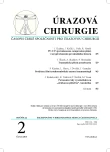Erratum
Published in:
Úraz chir. 22., 2014, č.2
Overview
AIM:
Aim of study was on the basis of the analysis dead victims with blunt trauma evaluated the role of thorax trauma as cause of mortality.
METHODOLOGY:
In this study were analysed dead polytrauma patients with blunt trauma in period 2010–2012.Were chosen group of 210 patients. Thorax trauma were found in 178 (85 %) of victims. We analysed cause of death, mechanism of injury and number of intrathoracic injuried complications of dead victims.
RESULTS:
From all victims were 139 (66 %) after road traffic accidents, 65 (31 %) falls accounted 65 (31 %) and 6 (3 %) with working trauma. Thoracic trauma directly accouts 101 (48 %) of the deaths due to trauma. Thoracic trauma is a contributing factor to others 78 (37 %) of death in patients with blunt trauma (mostly with serious craniocerebral injuries). As primary cause of mortality was bleeding from injuries of lung (laceration and contusion) in 93 patients, heart (rupture and contusion) in 72 , thoracic aorta (rupture) in 47 victims and injuries of others large intrathoracic vessels were in 17 dead. In victims with thoracic trauma as contributing factor of death were laceration or contusion of lung in 63 cases, contusion of heart in 14 patients with serious injuries of chest wall (flail chest, sternal fracture)
DISCUSSION:
Immediate mortality in polytrauma patients was significantly increasing with serious thoracic injuries. Same one in the place of accident and in early postinjuried period after admission in the hospital. Serious thoracic trauma was presented as second most frequent cause of mortality (35 %). Futher as one from others causes of the injuried death (35 %). It corresponded with our result of study, where serious thoracic trauma is besides craniocerebral injuries most frequent cause of mortality.
CONCLUSIONS:
Serious blunt thorax trauma is frequent cause of immediate and early death.
KEY WORDS:
Blunt thoracic trauma, cause of the death.
Labels
Surgery Traumatology Trauma surgeryArticle was published in
Trauma Surgery

2014 Issue 2
- Metamizole vs. Tramadol in Postoperative Analgesia
- Safety and Tolerance of Metamizole in Postoperative Analgesia in Children
- Metamizole in perioperative treatment in children under 14 years – results of a questionnaire survey from practice
- Obstacle Called Vasospasm: Which Solution Is Most Effective in Microsurgery and How to Pharmacologically Assist It?
- Possibilities of Using Metamizole in the Treatment of Acute Primary Headaches
Most read in this issue
- Prevention of venous thromboembolism in traumatology
- TRAUMATIC PULMONARY PSEUDOCYST (TPP)
- High-pressure spray gun injury of a hand - case report
- PC.C.P. (percutaneous compression plate) in the treatment of proximal femur fractures
